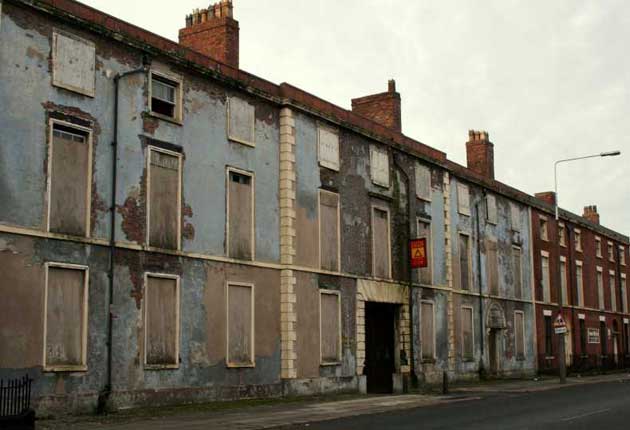Triumph, Disaster and Decay, milkandsugar, Liverpool
Pictures of a city that care forgot

Your support helps us to tell the story
From reproductive rights to climate change to Big Tech, The Independent is on the ground when the story is developing. Whether it's investigating the financials of Elon Musk's pro-Trump PAC or producing our latest documentary, 'The A Word', which shines a light on the American women fighting for reproductive rights, we know how important it is to parse out the facts from the messaging.
At such a critical moment in US history, we need reporters on the ground. Your donation allows us to keep sending journalists to speak to both sides of the story.
The Independent is trusted by Americans across the entire political spectrum. And unlike many other quality news outlets, we choose not to lock Americans out of our reporting and analysis with paywalls. We believe quality journalism should be available to everyone, paid for by those who can afford it.
Your support makes all the difference.No city, with the possible exception of Jericho, has suffered such a dramatic collapse as Liverpool. Within 100 years, it has gone from being one of the wealthiest in the world to one of the poorest in Europe. The Second World War, the decline of its port trade and the rise of containerisation all figured in its economic perdition, to say nothing of its wildcat politicians and other wilful saboteurs – even in 1935, the Communist Party were calling the place “an organiser’s graveyard”.
Yet Liverpool’s agony has also been an internal one, witnessed by residents and visitors alike, in the unceasing destruction of its architectural heritage. A bomb-site necropolis long after the Luftwaffe had visited, the city began an extraordinary programme of self-mutilation, starting with the demolition of John Foster’s magnificent Customs House in 1947, despite the fact that its war damage was quite reparable. This story of a disappearing city, which continues to the present day, is chronicled in a superb exhibition of photographs, Triumph, Disaster and Decay, at the milkandsugar gallery.
Laid out in two sections – the first an account of lost Liverpool, the second a report on those buildings under threat – its cumulative effect is at once heartbreaking and deeply shaming. That whole swaths of late-Georgian and early Victorian terraced houses still survived in suburbs such as Toxteth and Everton into the 1960s is almost as startling as the mass clearances that would soon condemn them. The city’s population crashed by half in the next 30 years. Jonathan Brown, in his catalogue essay “Liverpool Betrayed”, interestingly argues that the accepted history – people left because the docks closed – got it the wrong way round. The economy stalled because working people were cast out and marooned in distant housing estates.
Individual records of philistinism and neglect unfold across the gallery walls. Of the 19 churches in Everton described by Nikolaus Pevsner in 1969, only six remain. A photograph of Abercromby Square shows Foster’s church St Catherine’s, demolished in 1966 to make way for the university’s Senate House. More heartbreaking still is the fragment of wrought ironwork from a gallery inside the Old Sailors’ Home, a beautiful neo-Jacobean marvel senselessly destroyed in the 1970s. Canning Place, where it stood, itself no longer exists, swallowed up by the huge (and controversial) Paradise Street shopping centre, Liverpool One. It echoes another outrageous scarring, of elegant old Clayton Square, flattened to make way for another mall in 1986. By whose decree? The answer isn’t always clear, but a combination of rapacious property developers and incompetent councillors have usually done for it.
That legacy of near-criminal negligence seems to have been handed down through the DNA of Liverpool City Council. One might leave this exhibition feeling indignant and deeply depressed, for the disasters of the 1960s are returning, in the shape of the Government-sponsored Pathfinder schemes. Hearteningly, campaigns are being fought against further depredations. Elizabeth Pascoe still battles a road-widening scheme that would destroy 400 perfectly good family houses in and around Edge Lane. Florence Gersten also continues a valiant rearguard against municipal vandalism, having helped to save the Lyceum building in Bold Street back in the 1980s. Save Britain’s Heritage itself deserves immense credit for supporting the fightback, and for mounting this exhibition, splendidly curated by Robert Hradsky.
Why does it matter? Because when you obliterate familiar buildings and street patterns, you cut people off from a sense of belonging. The writer Iain Sinclair recently described landscape as a “refracted autobiography”. If we keep losing that landscape, we lose our sense of self. It’s a bitter lesson that Liverpool, even after the infamy it has endured, still seems reluctant to learn.
To 6 March (0151-707 4380)
Join our commenting forum
Join thought-provoking conversations, follow other Independent readers and see their replies
Comments